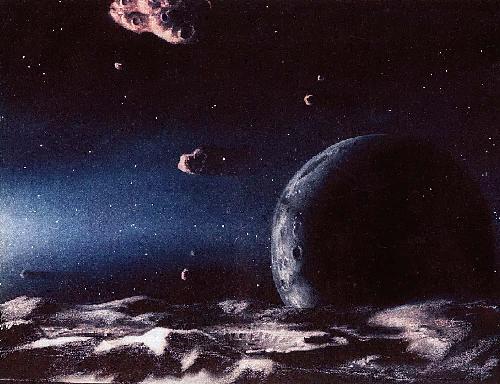| Object | H [mag] | p | D [km] | Type |
|---|---|---|---|---|
| 2003 UB313 | -1.2 | 0.86+/-0.07 | 2400+/-100 | Scattered |
| Pluto | -1.0 | 0.6 | 2320 | Plutino |
| 2003 EL61 | 0.4 | 0.6? | 1200? | Classical |
| 2005 FY9 | 0.3 | 0.6? | 1250? | Scattered |
| Charon | 1 | 0.4 | 1270 | Plutino |
| Sedna | 1.6 | 0.2? | <1500? | Detached |
| 2004 DW | 2.2 | 0.04/0.12 | ~1500 | Plutino |
| Quaoar | 2.6 | 0.12 | 1200+/-200 | Classical |
| Ixion | 3.2 | 0.09 | 1065+/-165 | Plutino |
| 2002 AW197 | 3.2 | 0.1 | 890+/-120 | Scattered |
| Varuna | 3.7 | 0.07+/-0.02 | 900+/-140 | Classical |
Introduction
As a growing area of the sky is searched for KBOs, we are beginning to
detect the larger, less abundant members of the size distribution.
These 1000 km diameter and larger objects are Pluto-like in
scale, and a factor of 10 times larger than
the more commonly measured KBOs. Some of them have been called
'Dwarf Planets', or more recently
Plutoids. The names don't matter
much: they are simply big KBOs.
Technique
Measurement of the size of a KBO is difficult. The apparent optical
brightness, corrected to a standard distance from the sun and Earth,
is called the "absolute magnitude", H. Absolute magnitude provides a measure of the product of the albedo of the KBO with the square of its diameter.
By taking thermal data as well as optical, it is possible to disentangle
the albedo from the squared diameter, and obtain separate values for
both. This is because high albedo objects of a given size are optically
bright but thermally cold (because they reflect, not absorb, most
of the sun's radiation) and therefore thermally faint. Conversely,
a low albedo object of the same size would be optically faint, but
thermally bright (because the surface absorbs most of the sunlight
and becomes warm).
This classical method for albedo and size determination was pioneered by the late David Allen in the 1970s, and has been widely applied to measure the sizes of asteroids using thermal measurements at 10 and 20 microns wavelength. KBOs are so far away and so cold that their thermal radiation peaks at longer wavelengths (nearer 60 to 70 microns) where the atmosphere of Earth is opaque. NASA's SIRTF has given the first large set of KBO albedos from measurements at these wavelengths with the result that albedos are scattered, with a representative value near 0.1. Ground-based astronomers have been able to measure extremely weak, long-wavelength thermal radiation from the submillimeter portion of the spectrum, but only from the largest objects. The SIRTF and submillimeter albedos do not always seem to agree, for reasons which remain arguable.
The Objects
The first characterised of these 1000 km scale KBOs was Varuna,
measured in
2001. In late 2002, the IRAM telescope reported
measurements of a KBO that may be even larger, the so-called Quaoar (pron:
"Kwaaah"). The latter is also marginally resolved by Space Telescope,
providing an independent (but still model-dependent) estimate of its
size.
The large KBO, 2004 DW, has an absolute magnitude like that of Quaoar, but no albedo has been measured. If the albedo is like Quaoar's, 0.12, the diameter is near 1500 km. If it is very bright (albedo 0.4, like Charon) it would be near 750 km in diameter. The diameters of all KBOs, other than Pluto-Charon, remain uncertain at the 10 to 20% level, at best. Most are little more than guesses.
In July 2005, 3 more KBOs in this large-size class were reported, including one (2003 UB313) that has an absolute magnitude brighter than Pluto's (suggesting that it must be larger).
Significance
The main significance of these 1000 km scale KBOs is that they confirm
extrapolations previously made from the size distribution of smaller
(100 km to 600 km diameter) KBOs. On a practical level, the 1000 km
objects are bright enough to permit meaningful physical studies (of
reflection spectra, colors, rotational lightcurves) which will
eventually help us understand something about the origin and processing
of KBOs.
A second result of note is that the very largest KBOs have mean albedos higher than the smaller ones. This suggests that the bigger KBOs retain materials of higher albedo, probably ice or frost, than can survive on the nuclei of comets that were used to make the 0.04 albedo guess. That they are still pretty dirty can be seen by comparison with frosty Pluto's very high albedo (0.6, see Table).
 |
Kuiper Belt |
|---|
Last Updated 2008 June